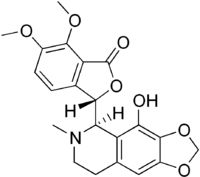Narcotoline
From Wikipedia, the free encyclopedia
| Narcotoline | ||
|---|---|---|
 | ||
| IUPAC name (3S)-3-[(5R)-4-hydroxy-6-methyl-7,8-dihydro-5H-[1,3]dioxolo[4,5-g]isoquinolin-5-yl]-6,7-dimethoxy-3H-2-benzofuran-1-one | ||
| Identifiers | ||
| CAS number | 521-40-4 | |
| PubChem | 442330 | |
| EC number | 208-313-6 | |
| Jmol-3D images | {{#if:CN1CCC2=CC3=C(C(=C2[C@@H]1[C@@H]4C5=C(C(=C(C=C5)OC)OC)C(=O)O4)O)OCO3|Image 1 | |
| ||
| Properties | ||
| Molecular formula | C21H21NO7 | |
| Molar mass | 399.39 g mol−1 | |
| Except where noted otherwise, data are given for materials in their standard state (at 25 °C (77 °F), 100 kPa) | ||
| Infobox references | ||
Narcotoline is an opiate alkaloid chemically related to noscapine. It binds to the same receptors in the brain as noscapine to act as an antitussive,[1] and has also been used in tissue culture media.[2]
Source
It can be obtained from the opium poppy, Papaver somniferum. It is present at much higher levels in culinary strains (cultivars) of P. somniferum used for poppy seed production than in high-morphine pharmaceutical strains used for opium production.[3]
References
- ↑ Karlsson, MO; Dahlström, B; Neil, A (1988). "Characterization of high-affinity binding sites for the antitussive 3Hnoscapine in guinea pig brain tissue". European Journal of Pharmacology 145 (2): 195–203. doi:10.1016/0014-2999(88)90230-0. PMID 3350041.
- ↑ US 2004063205 "Composition and method for culturing potentially regenerative cells and functional tissue-organs in vitro"
- ↑ Frick, S; Kramell, R; Schmidt, J; Fist, AJ; Kutchan, TM (2005). "Comparative qualitative and quantitative determination of alkaloids in narcotic and condiment Papaver somniferum cultivars". Journal of Natural Products 68 (5): 666–73. doi:10.1021/np0496643. PMID 15921406.
External links
This article is issued from Wikipedia. The text is available under the Creative Commons Attribution/Share Alike; additional terms may apply for the media files.